A leading vet said cattle producers should get on top of flies early before populations become unmanageable due to the significant impact they can have on stock.
Zoetis vet Ally Anderson said flies can impact the health, welfare and production of stock, so although fly control is an added cost at the outset, it will go on to have long-term benefits.
Impact of flies on cattle
Studies in cattle have shown that fly worry can cause growth rate losses of up to 0.3kg a day and 0.5l a day milk loss, mainly due to reduced feed intake. They can also transmit diseases like New Forest Eye and summer mastitis.
Control of flies
Ms Anderson said that although flies may not become an apparent problem in stock until early summer, treating before high numbers are seen will make control easier and more effective.
“Once you start seeing flies, the population has already exploded, making it harder to control them. This is why protecting stock early on in the spring is vital,” she said.
“Milder temperatures throughout the year can extend the fly season, with many farmers reporting flies as early as March and as late as November. This means treatment must be considered throughout the season and with a product that protects stock against the appropriate fly species.”
Fly control can be achieved by using:
Fly control ear tags, such as the Flectron tag
These offer up to five months of protection against nuisance and biting flies and have a zero-day meat and milk withdrawal.
They work by slowly releasing the active ingredient, cypermethrin, onto the tag’s surface. The tag acts as a constant reservoir of insecticide throughout the season. The active ingredient binds to the sebum or natural oil present in the animal’s coat and on the skin’s surface. This means when flies come into contact with the tagged animal, they will die within a few minutes.
Fly tags are easy to use, can be used in all ages of cattle, reduce the cost of extra handling and minimises production losses associated with handling.
Spot-on products, such as Fly & Lice Spot On and DYSECT
These can give up to eight weeks of protection in cattle, with a zero-day milk withdrawal. However, regular application is needed for control.
Ms Anderson added: “Any form of fly control is better than nothing, due to the economic, health and welfare implication of flies on stock. However, for peace of mind that stock are protected and to ease management, particularly when animals are outside grazing and are not brought into the parlour every day, then Flectron fly ear tags offer the best control option.”
Managing Fly Breeding Sites
Farmers can also help to reduce fly populations by managing breeding sites. Many fly species travel considerable distances to feed and survive over winter by their larvae burrowing into the ground. So, keeping stock away from fly breeding sites like wet and muddy areas can help reduce the risk.
Fly numbers can also be managed by:
- Improving ventilation in sheds to create unfavourable conditions;
- Providing good drainage;
- Using fly sheeting in high-risk areas;
- Keeping manure dry and compacted and turning it every 2-4 weeks; and
- Covering manure heaps and not overfilling slurry lagoons.
Monitoring flies
Monitoring flies on the farm using a bought or homemade fly trap allows farmers to take action early to prevent the population from increasing.
“As soon as you start seeing flies in the trap, you know they are going to be bothering stock and you may want to take appropriate action,” said Ms Anderson.


